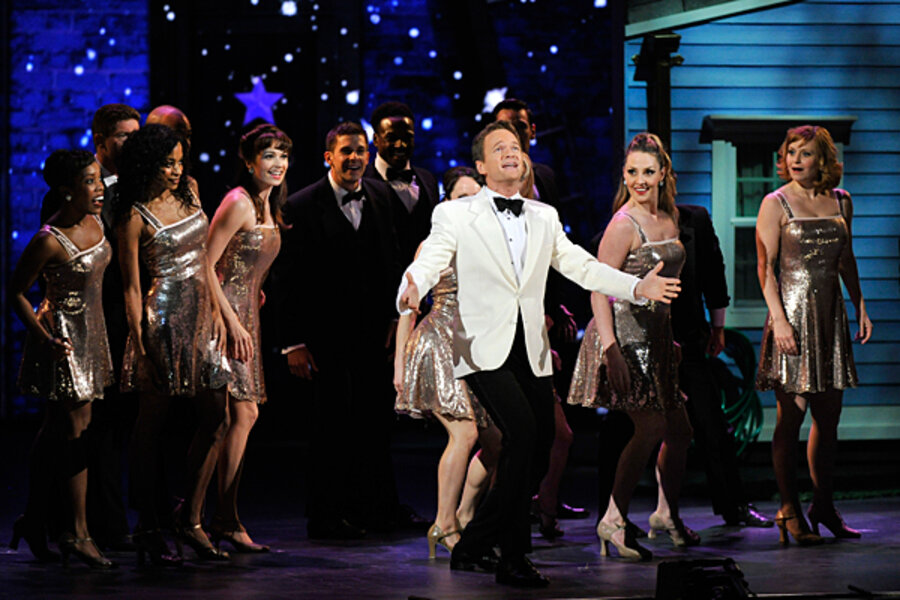Tony Awards put Broadway's booming box office on display
Loading...
| Los Angeles
The Tony Award show may have been down about 1 million viewers from last year, but it also offered encouraging signs about the state, health, and direction of American theater. Hand-in-glove with those positives, however, are some weaknesses and – as every year – some bewildering anomalies, say analysts and critics.
First on the good side. Broadway set a box office record without a centerpiece, must-see hit – such as last year’s “The Book of Mormon” – that drove attention to the Great White Way. That record could be due to soaring ticket prices, say some, as “Death of a Salesman" set a new high-mark for the highest ticket price ever charged ($499, beating out $480 from “The Producers” in 2001).
Producers admitted they upped the premium price after noticing that premium tickets were being sold in blocks to Connecticut and New Jersey zip codes – a sign that brokers were snapping them up in bulk and marking them up on websites, where a final performance ticket went for $1,600.
That shows demand is very high as long as the production is first rate.
Also on the good side – at least, according to some – is the influx of top-grade Hollywood talent, from Phillip Seymour Hoffman to Hugh Jackman.
“The Hollywood impact on New York’s theater environment has never been greater,” says Catherine Rodgers, professor of theater at Meredith College in Raleigh, N.C. Particularly for casual theatergoers, “the play itself might not be a draw but the A-list cast will be. Drawing a more diverse crowd rather than the typical New York, theatergoing audience will hopefully create broader appeal.”
Yet the Tonys showed that this starpower is not preventing the infusion freshness and creativity. Many of the successful productions on Broadway – such as Tony Award winner “Peter and the Starcatcher” – are coming from the nonprofit sector, where they’ve been in development before going to New York. And several winners Sunday upstaged many bigger names.
Two examples are Nina Arianda, winning best leading actress over better-known names such as Linda Lavin and Stockard Channing, and James Corden, who beat out the likes of Mr. Hoffman and John Lithgow.
“It was very remarkable that this unknown British actor won over these other big names. I’m excited about what that means for the health of the industry and what signal that sends to others on the way up,” says David Cregan, chair of Villanova University’s Department of Theatre.
But the thirst for top-rate productions – and – means more tickets are becoming more unafforable.
The flip side is the high cost, driving Broadway to become an elite luxury, rather than an artistic delight for the masses.
“Unfortunately for would-be theater enthusiasts, while the big names are generating more publicity for plays and musicals, they are simultaneously limiting the availability for the general public to go see a live performance,” says Ms. Rodgers of Meredith College.
Average paid admission has increased by one-fifth to $93 since before the recession, according to new statistics from the Broadway League – while non-musical ticket prices grew by about 3 percent. On a recent visit to New York, Rodgers says her family of four could only afford to see one play.
“Big names require big price tags and tickets easily soar into the triple digits now. Spending a night in the city for a family of four can easily exceed $1,000 just to go to dinner and a performance,” Rodgers says.
Moreover, because there are a lot of very strong revivals on Broadway right now – such as “Death of a Salesman” and “Porgy and Bess” – it is harder for an American play to get to the national stage. But this is good news to some.
“Consequently, the best American drama is happening in the regions, and if it is lucky, is making it to Broadway,” says Anthony Haigh, director of Centre at the Edinburgh Festival 2012 and professor of theater at Centre College in Danville, Ky. “Or even more trustworthy, from a producer's point of view, is a success in London. London – the new Off-off-off-Broadway!”





